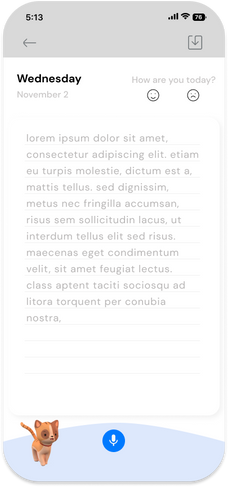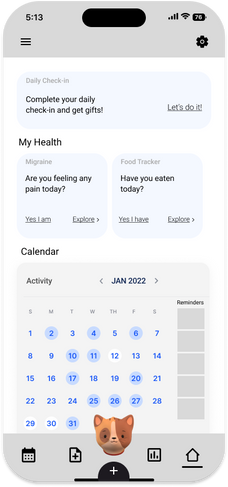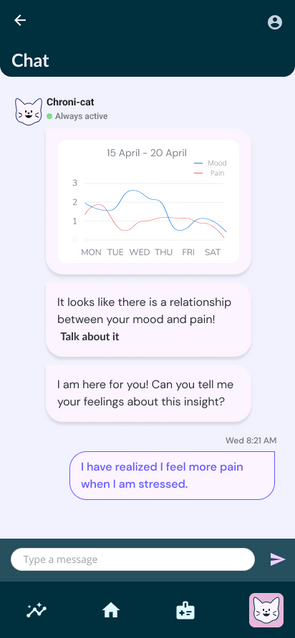
December 2022 | Case study.
Chroni-Cat
A gamified symptom tracker to Improve Self-Monitoring and Self-Reflection For Young Adult With Chronic Conditions.
Team
Xin Chen, Laura Vivian Pratt, Amanpreet Kaur.
My Role
Visual Design, Animation, Prototying.
Duration
3 months.
Problem Statement
Despite easy access to wearable devices for continuous health monitoring, lack of effective platforms that provide valuable insights to users with chronic health conditions, hinder their ability to manage their conditions effectively. This project aims to create an intuitive and informative interface for displaying health data, tailored to the needs of these users.



Why
One in three adults around the world lives with at least one chronic illness (Hajat & Stein, 2018). We looked into this population of adults to understand how technology and tracking abilities can help users better manager their chronic health conditions.
Accordingly, we decided to design Chroni-Cat; an application that supports multimodal input including speech-to-text, picture, calendar and click input, while providing gamification to motivate users to engage and reflect on their health journey.
Deep Dive
The following sections go deep into the process.
Discover
Background
We defined a few important terminologies that we will be following for the project research; A chronic condition is defined as a condition that lasts 12 months or longer and meets one or both of the following tests:
(a) it places limitations on self-care, independent living, and social interactions;
(b) it results in the need for ongoing intervention with medical products, services, and special equipment. (“Chronic Conditions”, 2022)
According to the Chronic Care Model (CCM) developed in the 1990s by Wagner et al. as a framework to improve the quality of chronic care, the six elements of the CCM operate within the context of the individual, community, provider organization and the health care system (Wagner et. al, 1996). Through this app, we hope to tackle the Self Management Support section of the Chronic Care Model.
Findings
On the basis of our findings, created the following HOW MIGHT WEs to understand the problem space better and have a fruitful user interview session.
Affinity Mapping
How Might We
Allow users to customize their experience without it overwhelming them.
Affinity Mapping
How Might We
Provide users the ability to automate reminders and alarms.
Affinity Mapping
How Might We
Ensure users feel secure about their data.
Affinity Mapping
How Might We
Motivate user engagement and tracking consistency.
Affinity Mapping
How Might We
Help reduce data input burden of repetitive data .
Affinity Mapping
How Might We
Ease user interaction with doctors and help build that relationship.
Affinity Mapping
How Might We
Make user interaction insightful and fruitful in a form of a greater understanding of their chronic conditions.
Define
User Research
-
User Interviews -
-
To kickstart the project, we spoke to 6 people suffering from chronic diseases, namely: Crohn's Disease, Multiple Sclerosis, Migraine, Chronic Endometriosis, Kidney transplant post care and heart disease.
-
-
We wanted to ask users the following questions:
a) How do users currently keep track of their medical journey?
b) What does daily chronic care management consist of?
c) How important is it for users to self reflect on their chronic care journey?
d) How do they stay motivated to continue tracking their chronic care journey?
Findings
On the basis of our findings, we grouped the users into Lifestyle Artists and Professional Patients in accordance with their personality types.
Lifestyle Artists
Tracking lifestyle habits to understand triggers.
User Group
P1
"I want motivation to pay more attention to my diet as it can trigger symptoms"
P6
"I do self-reflection when tracking to find out possible triggers for the symptoms"
P4
"I want to know more information about why and how my migraine occurs"
P4
"My goal is to be able to predict my flare ups so I can have better control over them"
P6
"I have been tracking my symptoms for over 10 years now to understand my condition"
P2
"I am on experimental treatment so its important for me to track how my body is reacting to it."
User Group
Professional Patients
Tracking medications, tests, reports and treatments for easy sharing.
P4
"I use reminders to track my symptoms and take medications"
P2
"I currently track my symptoms with appointments with my neurologist every 3 months"
P4
"My doctor has given me a form to fill with all my test results to share with him"
P2
"I forget to book my doctor appointments and monthly blood tests"
P3
"I like reminders for buying medication, booking regular appointments"
P3
"I log my symptoms but don’t know how it can help me alleviate the symptoms and make me feel better"
Design
User Experience
Based on our findings, we created a rudimentary user flow and information architecture to understand more about sketching needs.
-
Preliminary user flow - Click to zoom

-
Rudimentary information architecture - Click to zoom

Design
Design System
We created a design system to rely on before finalizing our sketches. We wanted the app to look youthful and energetic with high contrast to make it accessible to all. We also paid attention to color guidelines as per wcag 2.3 to make the app accessible to users with vision impairment.




Design
Wireframes & Rationale
Based on our findings from user research and team feedback, we have designed the following key features for our app:
Journal for qualitative tracking
-
Multi-modal capture allows for uses to add images, documents, reports along with text via simply typing or through dictation.
-
The journal can be searched using keywords, hence it can be used to capture symptoms and create a timeline.
-
Users can share their journals with their doctors if they wish to.
Cards for symptom logging:
-
Users can log their symptoms and events using individual chronic illness cards and symptom cards.
-
The cards and scales are customizable and can be set up by users according to their needs.
-
Users can quickly navigate through their logged symptom data using the calendar and gain insights on their chronic care journey.
App generated insights
-
Users can view insights on the data they have logged over specific periods of time, depending on their needs.
Your personal assistant
-
As a helping hand and a concerned pet, the personal pet assistant acts as a guide for users.
-
They can help users set up the app to make the best use of it and provide them with reminders for medication and appointments. Just have to sync specific incoming email accounts!
-
Users are awarded with unique gifts for their pet assistants every time they check-in with the app.
Design
Prototype
After brainstorming solutions to problems that surfaced during sketching, wire framing and peer feedback, we designed suitable solutions included in our hi-fidelity prototype
Onboarding flow
Users can be introduced to an initial set up using the personal assistant to help them understand the app's basic features. This is done to avoid overwhelming them with information. Users can start with a simple flow and explore more as they go.
Daily Check-In
Users have the option to use a series of checklists to quickly input their symptoms and medication, as well as review upcoming medical appointments, without having to exert a large amount of time and mental energy typing information into the application. Users can also set up their tracking devices and have the app automatically collect specific data from it.
Journaling
Users can use journaling to record their emotions or other aspects of their chronic care journey that cannot be captured by predefined fields of entry. This will be automatically added to their calendar to better connect their data to things that might have triggered such events. They also have the option of choosing to discuss their journal entry with their pet assistant to better understand the event.
Pet Assistant
Users will interact with their Pet Assistant throughout the use of the application. Users will receive rewards like new animations for their pets or new accessories like scarves and clothes when users interact with the app, to encourage users to maintain their tracking habits.
Users can also chat with their Pet Assistants when they want to know more about their insights.
Insights
From the various information visualizations we provide on Chroni-Cat, the user can choose a few different ways to manage and compare their tracked data. Users will also be provided new insights by the app, correlating symptoms across different conditions or lifestyle habits. We hope that this will help users understand their triggers better.
Evaluate
User Testing
-
Users were given 8 tasks and a SUS questionnaire to complete.
-
In total we have been able to conduct preliminary testing using a high-fidelity prototype of the app with 2 users. We plan on conducting more in the future.
-
Note: Since our prototype has limited user flows, these findings are very preliminary.

Discussion
Limitations
One of the foremost limitations we encountered while designing Chroni-Cat was that speech recognition technology is not advanced enough to function in the way we originally wanted for the speech input on our application. We had hoped to have it so that a user could speak their entire journal entry into the application, and then certain phrases and information could be pulled from that voice entry and be the extent of their logged symptoms. While we were able to implement a similar system, it is far more slimmed down than we had originally hoped.
Amendment
Since we first designed the app, ChatGPT has opened our mind to what AI can do. Hence we believe the chat bot in this app can be its biggest power, giving Chroni-Cat the boost it needs to provide the help it aims to.
Besides, we couldn’t test the prototype to its best capabilities as we would need to design the complete user paths for letting the user have free reign over their interaction with the interface. To understand and evaluate the optimal functionality of the app, a complete system that supports different users path is necessary and more extensive and longer usability testing is required.









































